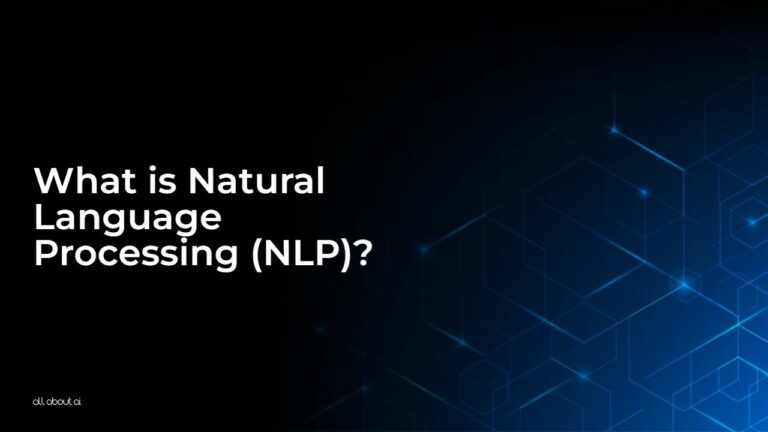What is Natural Language Processing (NLP)? Natural Language Processing, or NLP, stands as a pivotal branch of artificial intelligence (AI) that focuses on the interaction between computers and human languages. It aims to bridge the gap between human communication and machine understanding, allowing computers to read, decipher, interpret, and even generate human language in a valuable way.
Looking to learn more about the fascinating technology that is NLP? Continue reading this article written by the AI specialists at All About AI.
Understanding Natural Language Processing: A Closer Look at Machine Learning Models

NLP combines computational linguistics—rule-based modeling of human language—with statistical, machine learning, and deep learning models.
These models enable systems to process human language in the form of text or voice data and understand its full meaning, complete with the speaker or writer’s intent and sentiment. Here’s a closer look at NLP models.
Rule-Based Systems
Initially, NLP used rule-based systems, where linguists set rules for language interpretation. These systems were effective for structured tasks but struggled with complex language, leading to limited flexibility and adaptability in varied linguistic contexts.
Statistical Models
Statistical models in NLP marked a shift from rigid rule-based systems to more adaptable frameworks. These models learn from data, enabling them to handle the intricacies and variability of natural language better, offering improved accuracy in language processing tasks.
Machine Learning in NLP
Machine Learning revolutionized NLP by enabling algorithms to learn language patterns from large datasets. ML algorithms, through training, can make predictions or decisions, leading to significant improvements in language comprehension and response generation.
Deep Learning Revolutionizes NLP
Deep learning, using multi-layered neural networks, models complex language patterns. This approach has led to groundbreaking advancements in various NLP tasks, enhancing the capability of machines to understand and generate human language with remarkable accuracy.
How Does Natural Language Processing Function in Modern Technology?
NLP in modern technology involves complex processes starting from raw language input to sophisticated interpretation and response generation.
It includes stages like language modeling, parsing, semantic analysis, and discourse processing, using artificial intelligence and machine learning techniques for accurate human language interpretation.
Preprocessing Techniques in Natural Language Processing: From Tokenization to Tagging
In NLP, preprocessing is a critical step. It involves cleaning and converting text data into a form that can be easily analyzed. Techniques like tokenization (breaking text into words or sentences), stemming (reducing words to their base form), and part-of-speech tagging (identifying words as nouns, verbs, etc.) are commonly used.
Tokenization
Tokenization, the division of text into smaller units, simplifies language processing by breaking down text into manageable pieces. This foundational process is crucial for subsequent analytical tasks in NLP.
Stemming and Lemmatization
Stemming and lemmatization streamline text analysis. Stemming reduces words to a base form, while lemmatization considers usage and grammar, providing a more accurate understanding of the language.
Part-of-Speech Tagging
Part-of-Speech tagging assigns grammatical categories to words, enhancing the understanding of sentence structure. This process is vital for accurate syntactic analysis in various NLP applications.
What Techniques Are Utilized in Natural Language Processing?

Techniques like named entity recognition (identifying names, places, dates), sentiment analysis (determining positive or negative sentiments), and language modeling (predicting the next word in a sentence) are integral to NLP.
Named Entity Recognition (NER)
NER in NLP identifies key elements in text, classifying them into categories like names and places, which is essential for information extraction and data analysis tasks.
Sentiment Analysis
Sentiment analysis detects emotions in text, widely used in customer feedback analysis and social media monitoring. It helps in understanding public opinion and customer sentiments.
Language Modeling
Language modeling, predicting word sequences, is fundamental in various applications like text generation and speech recognition, enhancing the interaction between humans and machines.
Why is Natural Language Processing Crucial in Today’s Digital World?
NLP is essential for creating seamless and effective human-machine interactions. It is the driving force behind voice assistants, chatbots, and translation services, making technology more accessible and intuitive for all users.
- Enhancing Communication: NLP bridges the gap between human and machine language, enabling more intuitive interactions and improving the overall quality of human-machine communication.
- Automation and Efficiency: NLP-driven automation in customer service leads to enhanced efficiency, cost-effectiveness, and scalability in business operations.
- Data Analysis and Insight: NLP enables deep analysis of vast unstructured data sources, providing valuable insights for informed decision-making across different sectors.
- Accessibility: NLP technologies enhance accessibility, breaking language barriers and enabling people with disabilities to interact more effectively with technology.
What Are the Advantages of Natural Language Processing?
NLP enhances user experience, improves accessibility, automates and optimizes various business processes, and enables better decision-making through insightful data analysis.
Improved User Experience
NLP technologies create intuitive interfaces, significantly enhancing user experience by making interactions with machines and applications more natural and user-friendly.
Enhanced Accessibility
NLP increases technology accessibility, enabling broader audience reach, including those with disabilities, through voice commands and language translation features.
Business Process Optimization
NLP-driven automation in areas like data entry and customer support leads to significant efficiency improvements, optimizing business processes and contributing to cost savings.
Data-Driven Decision Making
NLP allows for the extraction of insights from unstructured data, aiding businesses in making informed decisions based on comprehensive data analysis.
Advancement in Healthcare
NLP’s role in healthcare includes improving patient data management and aiding in diagnostics, contributing significantly to patient care and medical research.
In What Ways is Natural Language Processing Applied in Various Fields?

NLP has diverse applications ranging from sentiment analysis in social media monitoring, chatbots in customer service, voice assistants in smart homes, to language translation services, and healthcare for patient data management.
Healthcare
In healthcare, NLP is crucial for managing patient records, extracting insights from clinical notes, and aiding in faster, more accurate diagnostics and personalized treatment strategies.
Finance
The finance sector uses NLP for market sentiment analysis, customer support automation, and fraud detection, enhancing operational efficiency and customer service.
Education
NLP transforms education by personalizing learning experiences, automating grading, and making educational content more accessible through language translation and summarization.
What Challenges Do Developers Face in Natural Language Processing?
Developers grapple with challenges such as understanding context, managing nuances in human languages, ensuring accuracy in different dialects, and maintaining ethical standards in language processing.
Contextual Understanding: The complexity of human language, with its nuances and contextual variability, presents significant challenges in developing accurate NLP systems.
Language Diversity: The vast diversity of languages and dialects poses a substantial challenge in developing universally effective NLP systems.
Ambiguity and Sarcasm: Detecting subtleties such as sarcasm or irony in text is a complex task, often leading to misinterpretations in language processing.
Ethical Considerations: Developing NLP technologies that are unbiased and ethically sound remains a critical concern, requiring ongoing attention and research.
Future Trends in Natural Language Processing:
The future of NLP holds promising advancements like more refined contextual understanding, enhanced multilingual support, and greater integration into various industries, further revolutionizing human-machine interaction.
Advancements in Contextual Understanding: Future NLP models will likely achieve a more nuanced understanding of context, enhancing human-machine communication.
Multilingual NLP: Developments in NLP will focus on improving multilingual capabilities, enabling better cross-cultural communication and understanding.
Voice and Speech Recognition: Future trends include more accurate and naturalistic voice recognition systems, enhancing user experience in various applications.
Ethical AI and NLP: The focus on ethical AI will intensify, leading to the development of more responsible and unbiased NLP applications.
Integration with IoT: The integration of NLP with IoT devices is expected to enhance human-device interactions, making them more natural and intuitive.
Step into the world of artificial intelligence through our specialized glossaries. Ideal for learners at every stage, anticipate ongoing new discoveries!Want to Read More? Explore These AI Glossaries!
FAQs
What is natural language processing NLP?
Why is natural language processing important?
What is natural language processing for dummies?
What is the difference between NLP and AI?
Conclusion:
Natural Language Processing stands as a testament to the incredible advancements in AI, bridging the gap between human language and machine understanding. As technology continues to evolve, NLP is set to play an even more significant role in transforming our interaction with the digital world.
This article provided an answer to the question, “what is natural language processing.” Here, we discussed its role in various industries, as well as challenges and future trends. If you’re looking to learn more about the wider world of artificial intelligence, check out the articles we have in our AI Key Terms Index.





